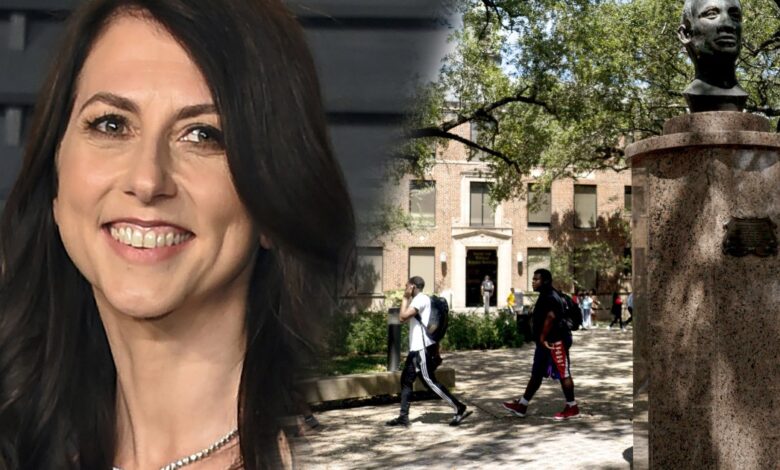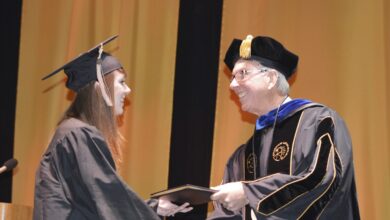MacKenzie Scott Donated $560 Million to 23 HBCUs. These Are the Other Things They Have in Common.

[ad_1]
But what distinguished the 23 institutions Scott chose from the other 78 accredited HBCUs that she didn’t?
Scott stressed that her approach to giving was data-driven with an emphasis on entrusting HBCU leaders with the freedom to decide how best to utilize the unrestricted funds. Scott didn’t make the decision on her own. In a Medium post from July of 2020, she wrote that she had a team of nonprofit advisers “with key representation from historically marginalized race, gender, and sexual-identity groups.”
A study led by a scholar from Rutgers University offers further insight. A report based on the study and released on Thursday used federal data from the National Center for Education Statistics to identify commonalities between the intuitions that were chosen in comparison with those that were not.
Among the findings: The HBCUs that received donations enrolled more first-time college students. On average, the median enrollment of first-time degree-seeking students in the entering classes of the chosen institutions was 716 compared with 349 in the other institutions. The HBCUs Scott chose also typically had higher tuition and fees — a median of $10,861, which was $2,293 higher than the median cost of those not receiving money from Scott. They had higher retention and graduation rates, too. The HBCUs chosen had, on average, a retention rate that was 15-percent than those that weren’t. On average, the institutions that received donations had six-year graduation rates that were 16-percent higher than the other HBCUs.
The findings can assist others who are interested in philanthropic giving to minority-serving institutions, said the report’s lead author, Marybeth Gasman, a professor in the Graduate School of Education at Rutgers, and Resche Hines, chief executive officer of Trivium BI, an organization that analyses and collects data. The report can also be a tool for the HBCUs themselves, the authors said.
“It’s just essential for HBCUs to be equipped regularly with data on their institution that they can easily present to people and, if they’re not satisfied with it, work to change those results,” said Gasman, who worked on the report with Hines and Angela Henderson, chief data architect at Trivium BI.
Another key distinction, and one that wasn’t as clearly evident from the federal data, was this: The institutions that were chosen also had consistent leadership.
“You do see across-the-board institutions that had strong leadership tended to get the donations,” said Gasman, who is also the executive director of the Rutgers Center for Minority Serving Institutions. “There are plenty of institutions that have long-term leaders or effective leadership that didn’t get it. But there might have been other reasons.”
She used the examples of Alcorn State University, which received $25 million from Scott, and Jackson State University, which wasn’t selected. While Jackson State outperforms Alcorn on many of the metrics Gasman’s team of researchers identified, Jackson State has seen more changes in leadership in recent years than Alcorn State has. In 2016, the former president, Carolyn Meyers, resigned amid criticism over her financial management of the institution; the following year, William B. Bynum Jr. held the position until he resigned after being arrested in a prostitution sting. After serving as acting president, Thomas K. Hudson was named the official president in 2020.
A majority of the HBCUs that received Scott’s donation used a large portion of the funding to bolster their endowments, most of which were relatively low when compared with neighboring predominantly white institutions, due in part to consistent underfunding from their states.
In March, Maryland’s Gov. Larry Hogan signed a bill to give $577 million to the state’s HBCUs over 10 years. The bill settled a federal lawsuit alleging discrimination and consistent underfunding of the state’s four HBCUs, including Bowie State and Morgan State Universities and the University of Maryland-Eastern Shore, which received donations from Scott. In Tennessee, a monthslong investigation by state-budget officials uncovered that one local HBCU — Tennessee State University — had been underfunded by as much as $544 million dating back to the 1950s. Tennessee State did not receive a donation from Scott. Similar cases of inequities in state funding of HBCUs have been observed in Mississippi and Alabama.
“Philanthropic gifts should supplement, not supplant, state and federal support,” said Kayla C. Elliott, director for higher-education policy at The Education Trust, a nonprofit research and advocacy group.
Elliott said that while the uptick in philanthropic dollars is encouraging, the state still has an obligation to its taxpayers, students, and the institutions themselves to ensure that they are fully funded and must make up for the long-standing resource inequities between HBCUs and PWIs.
One Maryland HBCU is using the funding as leverage for the state to provide recurring funds.
David Wilson, the president of Morgan State, used around $500,000 from Scott’s gift to create an ongoing annual $3 million appropriation toward staffing and research for Morgan State’s Center for Urban Health Equity. Morgan received $40 million from Scott.
“What Covid had laid bare was all of the racial inequities in this country around issues of public health, and this was quite timely,”Wilson said. “But had we not gotten that gift, then an annual $3 million appropriation that could go on in perpetuity would never have happened.”
The Biden-Harris administration has signaled increased support for these institutions, including a recommitment to HBCUs. Cares Act funding and other federal appropriations have allowed minority-serving institutions to wipe away student debt during the Covid-19 pandemic.
“It’s really sort of like a renaissance for HBCUs that you’re seeing,” Gasman said. “I hope that states will come to the realization that HBCUs are an important investment and that they should continue to increase allocations to them.”
“Will that happen?” she added. “I’m not sure.”
[ad_2]
Source link






